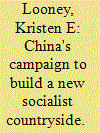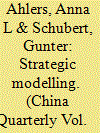| Srl | Item |
| 1 |
ID:
146517


|
|
|
|
|
| Summary/Abstract |
Ever since the introduction of the national political programme of “Building a new socialist countryside” (BNSC) in the early 2000s, renewed focus has been cast on how the Chinese government manages the gap between its rural and urban areas in the new millennium. Previous research has mostly studied the social and political consequences of the BNSC initiative without paying particular attention to its effects on public opinion. In this article, we present an analysis of the 2002 and 2008 waves of the mainland China subset of the Asian Barometer. Our results show a significant shift in the perceptions of the rural population in respect to how much impact government policies have on daily life. This shift brings rural perceptions more in line with those of the urban population in 2002. The paper concludes with the implications of our findings for the study of the relations between public opinion and public policy in China.
|
|
|
|
|
|
|
|
|
|
|
|
|
|
|
|
| 2 |
ID:
145742


|
|
|
|
|
| Summary/Abstract |
Since the mid-2000s, the Chinese government has promoted village modernization under the banner of “building a new socialist countryside.” To explain the origins and outcomes of this policy, this article examines the case of Ganzhou city in Jiangxi province. Ganzhou became a national model for rural development known for involving organizations called peasant councils in policy implementation. The study found that despite an initial emphasis on rural participation and moderate change, the new socialist countryside evolved into a top-down campaign to demolish and reconstruct villages. Three factors shaped this process: the strength of bureaucratic mobilization, the weakness of rural organizations, and shifting national policy priorities. After obtaining model status, Ganzhou's rural policy became more ambitious and politicized, leaving little space for participation. This insight suggests there are both benefits and costs to China's policy process. Despite the advantages of policy innovation, scaling up local experiments may actually undermine their success.
|
|
|
|
|
|
|
|
|
|
|
|
|
|
|
|
| 3 |
ID:
124889


|
|
|
|
|
| Publication |
2013.
|
| Summary/Abstract |
Models, pilots and experiments are considered distinctive features of the Chinese policy process. However, empirical studies on local modelling practices are rare. This article analyses the ways in which three rural counties in three different provinces engage in strategies of modelling and piloting to implement the central government's "Building a New Socialist Countryside" (shehuizhuyi xinnongcun jianshe) programme. It explains how county and township governments apply these strategies and to what effect. It also highlights the scope and limitations of local models and pilots as useful mechanisms for spurring national development. The authors plead for a fresh look at local modelling practices, arguing that these can tell us much about the realities of governance in rural China today.
|
|
|
|
|
|
|
|
|
|
|
|
|
|
|
|